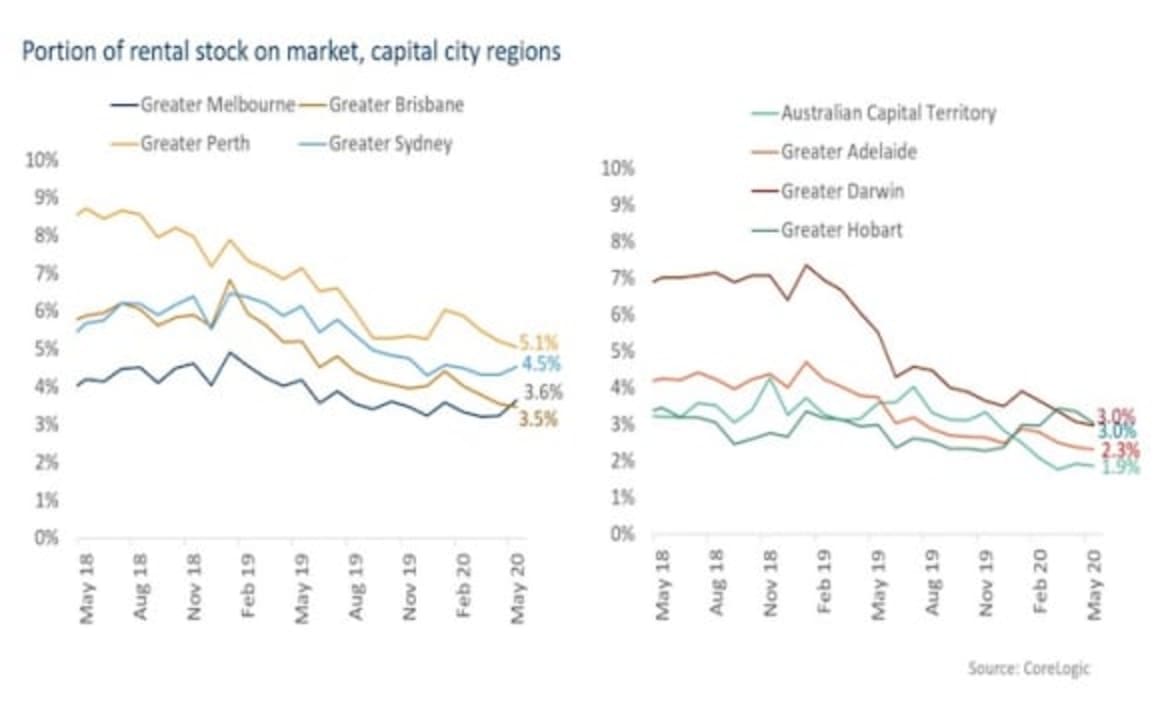Rental stock on market data shows Sydney and Melbourne markets loosen over May: CoreLogic's Eliza Owen

EXPERT OBSERVER
Amid COVID-19, much attention has been given to weaker rental market conditions. But as with buying and selling property, market conditions vary substantially among regions.
New data estimates from CoreLogic, calculating the portion of rental stock advertised, shows further variation in the performance of rental markets across different capital cities.
The percentage of rental housing advertised rose over the month of May in Sydney and Melbourne, while declining across the rest of the capital city regions.
4.5% of the total rental stock across Sydney was advertised over May, up from 4.3% in April. The portion of stock advertised across Melbourne saw an even larger jump, from 3.2% of listings advertised in April, to 3.6% of properties over May.
While 3.6% may sound small, it represents a total rent listing uplift of more than 3,000 across Melbourne, up to about 27,000 properties for rent over the month. This corresponds to a rise in vacancies, and falling rental prices, particularly in inner-city Sydney and Melbourne.
How is rental stock on market measured?
The calculation of rental stock on market is derived by dividing total rental listings in a month by the estimated rental stock in an area.
An increase in the portion of stock on market suggests higher vacancies and a looser rental market, which would coincide with falling rent prices. However, it could also be a function of a change in the ‘denominator’ – ie, the size of the rental market is reduced while listings are steady.
CoreLogic has a ‘static’ estimate of the portion of properties that are rented. To get a dynamic indication of rental stock, the portion of dwellings estimated to be rentals was interpolated between the rental tenure reported at the 2016 census, and the latest CoreLogic imputation of the portion of rental stock. So it assumes there is a linear movement in the portion of rental properties from 2016 to 2020.
A summary of the rental stock on market is presented below.
Click here to enlarge:

Click here to enlarge:

Why is stock piling up in Sydney and Melbourne and not elsewhere?
One of the big drivers of demand for rental accommodation is overseas migration. Most people that come to Australia from overseas, whether they are a skilled migrant, a temporary visa visitor or a refugee, will rent when they first come to Australia.
ABS data on migration suggests that Sydney and Melbourne received over 70,000 net overseas migrants over 2018-19, which is far higher than the other capital cities. This may be why an increasing amount of properties across the cities are sitting vacant.
Another factor contributing to less rental demand could relate to the predominance of Sydney and Melbourne for foreign student numbers. With foreign student numbers falling by close to 100% compared with a year ago, along with domestic students largely studying from home, rental demand from tertiary students has been depleted.
New South Wales and Victoria have also seen, by far, the largest number of investors relative to other states. According to ABS housing finance data, almost two thirds (65%) of investment loans over the past ten months were in Australia’s two largest states. Investor activity contributes to rental supply.
When paired with the large number of units that have been built over the past few years, many of which are rentals, and it’s clear that rental supply has increased more in Sydney and Melbourne relative to the other cities. Higher supply levels against a backdrop of weaker demand is a recipe for lower rents.
The steady level of advertised stock across the ACT came amid very little change to advertised stock levels and total rental stock levels. Declines in the rate of advertised rental stock in May across other cities were all due to a decline in the total listings count over the month.
In some areas, this could be a continuation of steady market conditions. The advertised stock levels suggest that rental markets have been gradually tightening in the lead up to COVID-19.
Perth in particular saw the portion of advertised stock decline over 200 basis points in the year to May, as both total rent listings, and the number of total rental properties declined. It may be the case that investors withdrawing from the market, where the property was sitting vacant for a long time, has helped to tighten rental conditions.
ELIZA OWEN is the Head of Research for Australia at CoreLogic